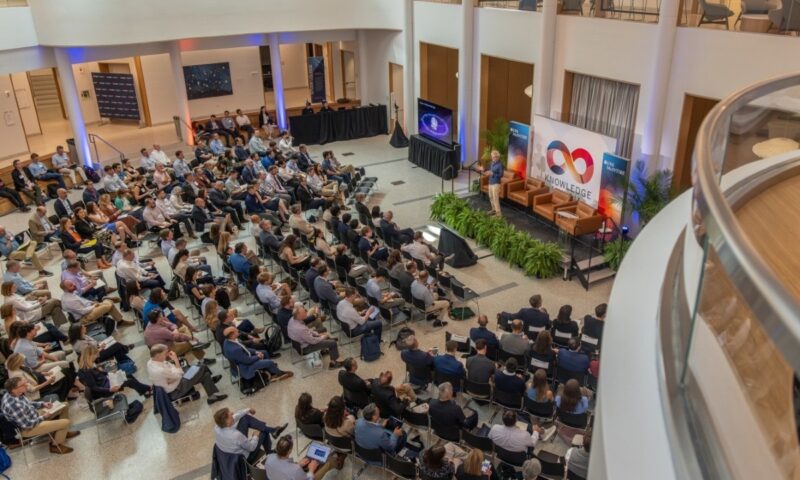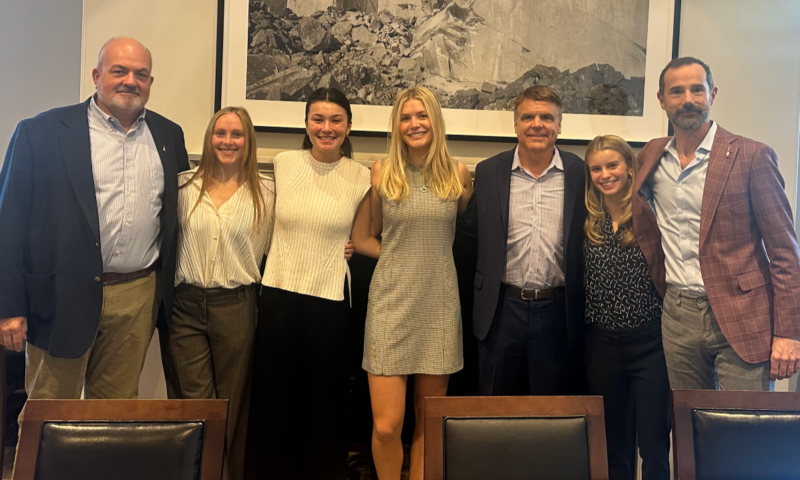The impact of the coronavirus pandemic is life-changing and momentous, and its global repercussions are spurring a staggering list of cancellations worldwide. Across UVA, and within McIntire, the spring 2020 schedule changes resulted in a dramatic call to rapidly reformat or wholly reconsider educational events, career conferences, global travel, and even Final Exercises, a seemingly unfathomable new reality for the UVA community.
But, even with a crisis of this magnitude, McIntire’s community-wide resolve is cause for hope and enthusiasm.
As the University took necessary precautions by canceling face-to-face classes and prohibiting the majority of students from returning to Grounds, Comm School faculty, staff, and students came together in an unprecedented way: In one week’s time, all McIntire courses were transformed into very functional online learning experiences.
The whirlwind effort required a multipronged approach that relied on a healthy dose of staff initiative and commitment, faculty flexibility and inventiveness, and the collaborative power of eager, energetic students.
A Virtually Herculean Achievement
With the remote learning edict in place, many University stakeholders expressed serious and legitimate concerns about taking courses online, imagining it would require a much longer time to ensure proper execution. The McIntire School, however, thanks to its remote teaching experience and the can-do attitude of its staff and faculty, lobbied for an aggressive schedule to get the semester restarted in the virtual world.
So, like a huge portion of the world now working from home, faculty were suddenly delivering their content via the videoconferencing platform Zoom like veteran users. Although some faculty previously taught with similar software platforms for years, it was a completely new experience for many others. The transition for all McIntire faculty was facilitated through a series of crucial tutorial sessions, timely troubleshooting help, and continued guidance from Classroom Support Manager Erik Pearson and Support Technicians Geoff Otis and Matthew Gatto.
Things moved fast. Within a few days of the University’s online directive, McIntire classes were back in session, conducted mostly from professors’ home offices.
After just the first few sessions, positive reactions began coming in from faculty teaching McIntire’s hallmark Integrated Core Experience (ICE) courses.
Professor Saonee Sarker was energized: “Just got off our first ICE (Block 3) session. Everything went very, very smoothly. Students were positive and engaged, and we loved every bit of it.”
“Class went surprisingly well,” said Professor Ryan Nelson. “The technology worked well (despite a few connection issues from time to time), and it was good to see the students’ faces. In general, the students seemed to be in good spirits and enjoyed connecting with us and each other…even if it wasn’t in person.”
Professor David Lehman concurred. “Yes, things went great for our block as well. One hundred percent attendance, and students were in very good spirits. I am very encouraged!”
Contextualizing the incredible accomplishment of the bright start, Professor Roger Martin noted, “If we had paused one week ago to speculate that we’d be pleased with the first day, I’m not sure many of us would have been brazen enough to predict even half of these positive comments and outcomes.”
Peer-to-Peer Connections
As teaching from home becomes the new normal, many faculty members are also learning from each other. Professors Roger Martin and Bryan Lewis were singled out for sharing their knowledge, helping to adjust Zoom classroom features, and answering lingering questions.
Beyond the immediate need to become adept on the platform, faculty also seized the online migration as an opportunity to collaborate.
“Members of our ICE team practiced meetings with each other; we shared our list of best practices and resources we found helpful; and on our team, we set up a Google doc where we can share what works and what needs more work,” said Professor Marcia Pentz. “We’re learning together, and that spirit of can-do optimism coupled with good humor and a desire to help is making the transition online much less intimidating.”
“I feel very supported by McIntire leadership, faculty peers, the technology teams, and staff,” Professor Jeffrey Leopold said. “I really feel like everyone has stepped up to be helpful and to be sure things go well. I am pleased to be a part of this team, and I hope I am contributing as much as everyone else is.”
Those contributions were evident School-wide. The dedication of staff include that of IT’s Eric Rzeszut, Jane Pace, and Brad Miller; Instructional Design’s Alan Hoover and Stephanie Conley; as well as Academic Support’s Serrell Stoke, Karen Gellner, and Amy Barger, who were each named by faculty for helping them rise to the challenges of the new learning environment.
All Hands on Deck
Perhaps some of the earliest adopters of the new entirely online learning environment were students. The totality of the McIntire student body demonstrated a tremendous ability to leap into the new format, both as willing learners and able partners in program delivery. After a shift in responsibilities brought about by COVID-19, a group of student workers unanimously offered to reframe their School service, stepping in as classroom moderators.
Realizing the faculty would benefit from another person helping facilitate the technology during live classes online, student workers—the majority of whom are enrolled at McIntire—jumped in, freeing up faculty to focus on their teaching. Students are assisting with many tasks: troubleshooting AV issues, contacting support in the event of any complex technical problems, moderating the chat space and answering technical questions from student participants, providing class etiquette information, and relaying content questions to faculty members.
For many faculty, the results were nothing short of game changing.
“It’s pivotal. Whoever came up with the moderator idea is a genius,” said Professor Trey Maxham. “It’s incredibly valuable. I can’t imagine why a professor would not want this help.”
Professor Adam Koch confessed it took some convincing to warm up to the idea of this particular type of collaborating with students. “Roger [Martin] basically nagged me into trying a moderator. I finally caved and am very glad that I did,” he said. “It was super helpful to have someone else there to flag me right away and help me brainstorm when something went wrong and to chat with a student privately off to the side when having technical problems. The pressure’s kind of on when you’re teaching and trying to use a new technology at the same time. So having a level head in the (virtual) room was great.”
Conley says that these responses are the norm. “It’s not an overstatement to say that our student workers have been integral to the success we’ve had in taking so many courses online so quickly,” she said. “Because this was such a fast transition, and something that many of our faculty had never done before, it’s been very beneficial to just have someone there in a general support role. Faculty have been so appreciative of the fact that they are not alone in dealing with the technology and logistics of running the class at the same time as delivering the content.”
Elizabeth Farrell (McIntire ’20), a moderator in courses taught by Professors Maxham, Dot Kelly, and Mark White, finds it interesting that, although all of the professors are employing the same Zoom interface, the in-class structure still varies, with each faculty member making it their own.
“Some professors are doing more of a flipped class, so they pre-record lectures to watch before so that class time is devoted solely to questions and discussions. I have found that very helpful and effective,” she said. “Professor White’s class is very discussion-based—he utilizes the breakout rooms function for smaller groups before bringing the whole class together. I also have found that the chat is somewhat of a safety zone for students. Some classes really lean on it, and others are not afraid to just unmute and start talking! I think the current situation is really good training for the future in terms of online collaboration.”
Essential Access
With students quickly connected to their courses, professors, and each other via Zoom, one issue lingered: the computer labs in Rouss & Robertson Halls.
Housing site-specific software that requires students to use the PCs in person, they would remain unavailable were it not for the ingenuity and entrepreneurial spirit of McIntire IT staff members.
“I realized that our lab computers would be a huge asset to us in a remote work situation, as they’d be unused otherwise,” Rzeszut said. “[Enterprise Systems Support Engineer] Rob Chang took the lead on making it work from a technical perspective, with testing help from [Help Desk Manager] Blake Omohundro.”
The trio developed a page to display the availability of the different workstations in real time. “We also called on [Assistant Director of Web Development] Megan Copper to improve the look of that page,” Rzeszut added.
The workstations were quickly configured to allow remote connections.
The initiative to reconfigure the lab PCs yielded practically seamless access for Comm School students learning remotely from their homes across the globe. Despite whatever new technical roadblocks may emerge during this uncertain time, students can rely upon the new configuration that supports connections to the 167 lab computers, ensuring continued access to applications (e.g., Anaconda, Crystal Ball, JMP, Query Express, RapidMiner, among others) central to spring courses, as if they were still on Grounds.
This speedy and sound modification of important resources offers yet another example of the vision, adaptability, and perseverance at the core of the School’s mission to provide the best global business education anywhere—even in the online learning space.
It’s often been said that “At McIntire, innovation is our tradition.” The past few weeks proved that this statement rings truer than ever.



